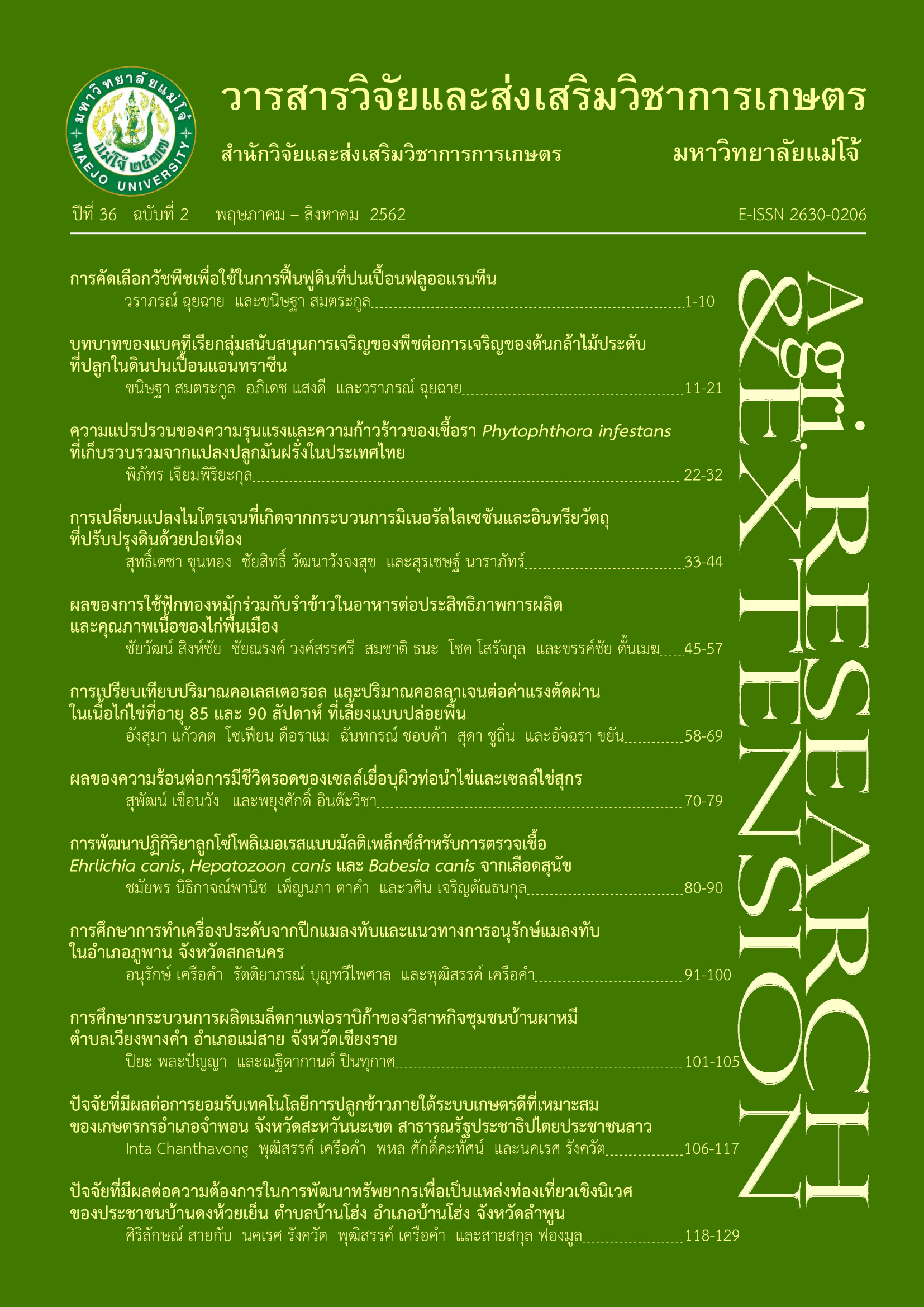การพัฒนาปฏิกิริยาลูกโซ่โพลิเมอเรสแบบมัลติเพล็กซ์สำหรับการตรวจเชื้อ Ehrlichia canis Hepatozoon canis และ Babesia canis จากเลือดสุนัข
คำสำคัญ:
Ehrlichia canis, Hepatozoon canis, Babesia canis, ปฏิกิริยาลูกโซ่โพลิเมอเรส, แบบมัลติเพล็กซ์, เลือดบทคัดย่อ
งานวิจัยนี้พัฒนาเทคนิคปฏิกิริยาลูกโซ่โพลีเมอเรสแบบมัลติเพล็กซ์ต่อเนื่องจากการศึกษาก่อนหน้านี้ที่ตรวจได้เพียงเชื้อ Ehrlichia canis และ Babesia canis จากตัวอย่างเลือดสุนัข ในการศึกษานี้ผู้วิจัยพัฒนาเทคนิคปฏิกิริยาลูกโซ่โพลิเมอเรสแบบมัลติเพล็กซ์เพื่อตรวจหายีน VirB9 ของ Ehrlichia canis และ 18S rRNA ของ Hepatozoon canis และ Babesia canis ในตัวอย่างเลือดของสุนัข การติดเชื้อ E. canis (ริกเกตเซีย) H. canis (โปรโตซัว) และ B. canis (โปรโตซัว) ก่อให้เกิดโรคเออลิชิโอสิส (Ehrlichiosis) โรคเฮปปาโตซูโนสิส (Hepatozoonosis) และโรคบาบีซิโอสิส (babesiosis) ในสุนัข ตามลำดับ เชื้อก่อโรคทั้งสามชนิดมีพาหะร่วมกัน คือ เห็บสุนัขสีน้ำตาล (Rhipicephalus sanguineus) สุนัขที่ติดเชื้อมักแสดงอาการโลหิตจาง เป็นไข้ และอ่อนเพลีย วิธีการวินิจฉัยโรคนี้ในปัจจุบันใช้วิธีการย้อมฟิล์มเลือดบางด้วยสี Wright-Giemsa วิธีปฏิกิริยาลูกโซ่โพลิเมอเรส และวิธี Immunochromatographic ซึ่งใช้ตรวจหาแอนติบอดีต่อเชื้อ ในวิธีการต่างๆ เหล่านี้ วิธีปฏิกิริยาลูกโซ่โพลิเมอเรส มีความไวในการตรวจพบเชื้อสูงที่สุด แต่ใช้ระยะเวลาการตรวจนานที่สุด โดยเฉพาะอย่างยิ่งเมื่อตรวจหาเชื้อก่อโรค ทีละเชื้อ เทคนิคปฏิกิริยาลูกโซ่โพลิเมอเรสแบบมัลติเพล็กซ์ที่พัฒนาขึ้นนี้คาดว่าจะช่วยลดระยะเวลาในการวินิจฉัยโรคทั้งสามได้
เอกสารอ้างอิง
Allison, R.W. and S.E. Little. 2013. Diagnosis of rickettsial diseases in dogs and cats. Veterinary Clinical Pathology42(2): 127-144.
Baneth, G. 2011. Perspectives on canine and feline hepatozoonosis. Veterinary Parasitology 181(1): 3-11.
Bell, C.A. and R. Patel. 2005. A real-time combined polymerase chain reaction assay for the rapid detection and differentiation of Anaplasma phagocytophilum, Ehrlichia chaffeensis, and Ehrlichia ewingii. Diagnostic Microbiology and Infectious Disease 53: 301-306.
Carrade, D.D., J.E. Foley, D.L. Borjesson and J.E. Sykes. 2009. Canine granulocytic anaplasmosis: a review. Journal of Veterinary Internal Medicine 23: 1129-1141.
Chomel, B. 2011. Tick-borne infections in dogs-an emerging infectious threat. Veterinary Parasitology 179(4): 294-301.
Harrus, S. and T. Waner. 2011. Diagnosis of canine monocytotropic ehrlichiosis (Ehrlichia canis): an overview. The Veterinary Journal 187: 292-296.
Jittapalapong, S., O. Rungphisutthipongse, S. Maruyama, J.J. Schaefer and R.W. Stich. 2006. Detection of Hepatozoon canis in stray dogs and cats in Bangkok, Thailand. Annals of the New York Academy of Sciences 1081: 479-488.
Kongklieng, A., T. Thanchomnang, P.M. Intapan, T. Boonmars, P. Janwan, O. Sanpool, V. Lulitanond, P. Taweethavonsawat, S. Chungpivat, N. Morakote and W. Maleewong. 2014. Detection of Ehrlichia canis in canine blood samples by real-time fluorescence resonance energy transfer (FRET) PCR and melting curve analysis. The Southeast Asian Journal of Tropical Medicine and Public Health 45(5): 1149-1156.
Laummaunwai, P., P. Sriraj, R. Aukkanimart, T. Boonmars, S. Boonjaraspinyo, S. Sangmaneedet , P. Potchimplee, P. Khianman and W. Maleewong. 2014. Molecular detection and treatment of tick-borne pathogens indomestic dogs in Khon Kaen, Northeastern Thailand. The Southeast Asian Journal of Tropical Medicine and Public Health 45(5): 1157-1166.
Little, S.E. 2010. Ehrlichiosis and anaplasmosis in dogs and cats. Veterinary Clinics of North America; Small Animal Practice 40(6): 1121-1140.
Liu, M., N. Ruttayaporn, V. Saechan, C. Jirapattharasate, P. Vudriko, P.F. Moumouni, S. Cao, T. Inpankaew, A.P. Ybañez, H. Suzuki and X. Xuan. 2016. Molecular survey of canine vector-borne diseases in stray dogs in Thailand. Parasitology International 65(4): 357-361.
Modrý, D., R. Beck, K. Hrazdilová and G. Baneth. 2017. A review of methods for detection of hepatozoon infection in carnivores and arthropod vectors. Vector-Borne and Zoonotic Diseases 17(1): 66-72.
Nithikadpanich, C., R. Praphruet, N. Inkeaowpoungkham, N. Peepim, T. Khemasathid and W. Charerntantanakul. 2018. Development of multiplex polymerase chain reaction for the detection of Babesia spp. and Ehrlichia canis in dog blood. Journal of Agricultural Research and Extension 35(2): 34-43. [in Thai]
Pantchev, N., S. Pluta, E. Huisinga, S. Nather, M. Scheufelen, M.G. Vrhovec, A. Schweinitz, H. Hampel and R.K. Straubinger. 2015. Tick-borne Diseases (Borreliosis, Anaplasmosis, Babesiosis) in German and Austrian dogs: status quo and review of distribution, transmission, clinical findings, diagnostics and Prophylaxis. Parasitology Research 114 (Suppl 1): S19-54.
Peleg, O., G. Baneth, O. Eyal, J. Inbar and S. Harrus. 2010. Multiplex real-time qPCR for the detection of Ehrlichia canis and Babesia canis vogeli. Veterinary Parasitology 173: 292-299.
Piratae, S., K. Pimpjong, K. Vaisusuk and W. Chatan. 2015. Molecular detection of Ehrlichia canis, Hepatozoon canis and Babesia canis vogeli in stray dogs in Mahasarakham province, Thailand. Annals of Parasitology 61(3): 183-187.
René-Martellet, M., I. Lebert, J. Chêne, R. Massot, M. Leon, A. Leal, S. Badavelli, K. Chalvet-Monfray, C. Ducrot, D. Abrial, L. Chabanne and L. Halos. 2015. Diagnosis and incidence risk of clinical canine monocytic ehrlichiosis under field conditions in Southern Europe. Parasites & Vectors 8: 3.
Skotarczak, B. 2003. Canine ehrlichiosis. Annals of Agricultural and Environmental Medicine 10: 137-141.
Solano-Gallego, L., A. Sainz, X. Roura, A. Estrada-Peña and G. Miró. 2016. A review of canine babesiosis: the European perspective. Parasites & Vectors 9(1): 336.
ดาวน์โหลด
เผยแพร่แล้ว
รูปแบบการอ้างอิง
ฉบับ
ประเภทบทความ
สัญญาอนุญาต

อนุญาตภายใต้เงื่อนไข Creative Commons Attribution-NonCommercial-NoDerivatives 4.0 International License.
บทความนี้ได้รับการเผยแพร่ภายใต้สัญญาอนุญาต Creative Commons Attribution-NonCommercial-NoDerivatives 4.0 International (CC BY-NC-ND 4.0) ซึ่งอนุญาตให้ผู้อื่นสามารถแชร์บทความได้โดยให้เครดิตผู้เขียนและห้ามนำไปใช้เพื่อการค้าหรือดัดแปลง หากต้องการใช้งานซ้ำในลักษณะอื่น ๆ หรือการเผยแพร่ซ้ำ จำเป็นต้องได้รับอนุญาตจากวารสาร





